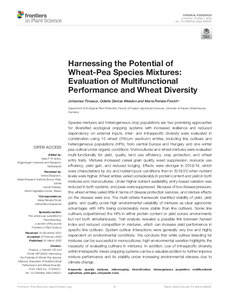| dc.date.accessioned | 2022-05-30T13:05:45Z | |
| dc.date.available | 2022-05-30T13:05:45Z | |
| dc.date.issued | 2022-03-25 | |
| dc.identifier | doi:10.17170/kobra-202205176192 | |
| dc.identifier.uri | http://hdl.handle.net/123456789/13874 | |
| dc.description.sponsorship | Gefördert durch den Publikationsfonds der Universität Kassel | ger |
| dc.language.iso | eng | eng |
| dc.rights | Namensnennung 4.0 International | * |
| dc.rights.uri | http://creativecommons.org/licenses/by/4.0/ | * |
| dc.subject | species mixtures | eng |
| dc.subject | intercropping | eng |
| dc.subject | diversification | eng |
| dc.subject | heterogeneous population | eng |
| dc.subject | multifunctional agriculture | eng |
| dc.subject | yield gain | eng |
| dc.subject | composite cross | eng |
| dc.subject.ddc | 580 | |
| dc.subject.ddc | 630 | |
| dc.title | Harnessing the Potential of Wheat-Pea Species Mixtures: Evaluation of Multifunctional Performance and Wheat Diversity | eng |
| dc.type | Aufsatz | |
| dcterms.abstract | Species mixtures and heterogeneous crop populations are two promising approaches for diversified ecological cropping systems with increased resilience and reduced dependency on external inputs. Inter- and intraspecific diversity were evaluated in combination using 15 wheat (Triticum aestivum) entries, including line cultivars and heterogeneous populations (HPs), from central Europe and Hungary and one winter pea cultivar under organic conditions. Monocultures and wheat mixtures were evaluated multi-functionally for yield, quality, land use efficiency, crop protection, and wheat entry traits. Mixtures increased cereal grain quality, weed suppression, resource use efficiency, yield gain, and reduced lodging. Effects were stronger in 2018/19, which were characterized by dry and nutrient-poor conditions than in 2019/20 when nutrient levels were higher. Wheat entries varied considerably in protein content and yield in both mixtures and monocultures. Under higher nutrient availability, entry-based variation was reduced in both systems, and peas were suppressed. Because of low disease pressure, the wheat entries varied little in terms of disease protection services, and mixture effects on the disease were low. The multi-criteria framework identified stability of yield, yield gains, and quality under high environmental variability of mixtures as clear agronomic advantages with HPs being considerably more stable than line cultivars. Some line cultivars outperformed the HPs in either protein content or yield across environments but not both simultaneously. Trait analysis revealed a possible link between harvest index and reduced competition in mixtures, which can increase yield performance in specific line cultivars. System cultivar interactions were generally very low and highly dependent on environmental conditions. We conclude that while cultivar breeding for mixtures can be successful in monocultures, high environmental variation highlights the necessity of evaluating cultivars in mixtures. In addition, use of intraspecific diversity within interspecific mixed cropping systems can be a valuable addition to further improve mixture performance and its stability under increasing environmental stresses due to climate change. | eng |
| dcterms.accessRights | open access | |
| dcterms.creator | Timaeus, Johannes | |
| dcterms.creator | Weedon, Odette Denise | |
| dcterms.creator | Finckh, Maria Renate | |
| dc.relation.doi | doi:10.3389/fpls.2022.846237 | |
| dc.subject.swd | Weizensorte | ger |
| dc.subject.swd | Vielfalt | ger |
| dc.subject.swd | Zwischenfruchtbau | ger |
| dc.subject.swd | Landwirtschaft | ger |
| dc.subject.swd | Getreidebau | ger |
| dc.type.version | publishedVersion | |
| dcterms.source.identifier | eissn:1664-462X | |
| dcterms.source.journal | Frontiers in Plant Science | eng |
| dcterms.source.volume | Volume 13 | |
| kup.iskup | false | |
| dcterms.source.articlenumber | 846237 | |


